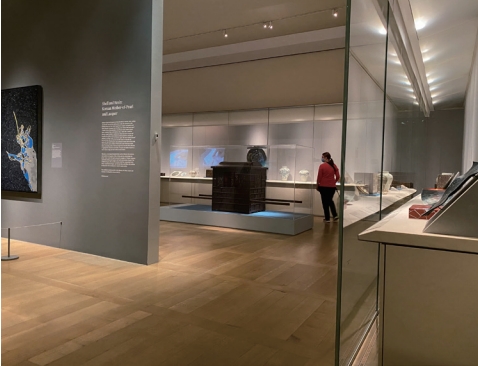December 13, 2021 - July 5, 2022
Metropolitan Museum of Art
1000 Fifth Avenue, New York NY 10028
This anticipated exhibition is the first special exhibition organized by Eleanor Soo-ah Hyun, Associate Curator of Korean Art at the Metropolitan Museum of Art. When Hyun started her position at the Metropolitan Museum of Art in 2019, after four years at the British Museum in London, she pledged to spend much time assessing what was available in the collection. “Shell and Resin: Korean Mother-of-Pearl and Lacquer” is a welcome product in discovering the depth, breadth, and variety of art works in the museum’s Korean collection. About 30 works, tracing the history of Korean mother-of-pearl techniques and lacquer objects from the Goryeo dynasty to the present, were selected for this exhibition.
Lacquer boxes made with mother-of-pearl sea shells are familiar and a number of them have been exhibited at the museum’s Korean Gallery previously. Most lacquerware pieces, such as a document box, a stationery box, or a clothing box, date from the Joseon dynasty. This exhibition opens with a 12th-century trefoil-shaped covered box ornamented with chrysanthemums.
1 This trefoil wooden box showcases exquisite mother-of-pearl inlays in minuscule f loral patterns combined with tortoise shell over pigment and brass wire. The intricate f loral shape of the box is outlined by brass wire.
Peony, f loral vines, and grapes are most common decorative patterns found on the lacquerware. The exhibition is organized thematically by motifs such as f lowers, horses, dragons, and so on. Within each theme, one can trace a chronological development from the early Joseon dynasty to the late Joseon and to the present. Each theme also encompasses art works made of media other than lacquer to further highlight the popularity of these motifs. For example, the section themed with horses and dragons includes a 5th-century long-necked jar with equine decorations, a Silla-dynasty stoneware, and a 12th-century Goryeo bronze mirror adorned with dragons. The section themed with peony includes group of small, Goryeo-era celadon bottles.
Caption 1.
An exhibition view of “Shell and Resin” this is an exhibition title. at the Metropolitan Museum of Art. Photo: Kyunghee Pyun, 2022

Caption 2.
A palanquin and a video screen at the Korean Gallery, Metropolitan Museum of Art. Photo: Kyunghee Pyun, 2022.

The exhibition ends with 21st-century works by Chung Haecho, Kim Hyunju, Kim Seol, and Son Daehyun. Chung’s contemporary lacquer bowls defy a geometric convention and are presented in a wide range of hues of lacquer, from red and green to vibrant yellow. By the entrance to the exhibition and the accompanying wall text, visitors are greeted with two contemporary works: Son Daehyun’s Hexagonal Vessel with Cover Decorated with Peonies (2018) and Lee Bul’s mixed-media work Perdu X (2018) Work title. in Italics, please.
Two exhibition elements — a four-minute video documentary showing Chung’s work process and the 20th-century wooden palanquin coated in resin — are especially popular draws of the exhibition.
2 Many visitors snap pictures of Lee Bul’s lacquer panel of a cyborg figure and show interest in the contemporary lacquerware by Chung, Kim, and others. Overall, the f low of the exhibition is inviting and encourage viewers to realize the aesthetic, creative potential of the medium itself.
Less familiar objects in the exhibition include a 15th-century horse saddle and mid-size furniture made of not only seashell but also inlaid ray skin and tortoiseshell.
3 The comparative examples of Chinese, Japanese, and Ryūkyū lacquers on display are also remarkable. Art works in other media, such as porcelain and bronze, were also shown to explain common motifs of lacquerware found in other types of decorative arts; more explanation regarding the intention behind showcasing these comparative materials would have been welcome.
The layout and structure of this exhibition is reminiscent of the Met museum’s 2018 exhibition “Diamond Mountain: Travel and Nostalgia in Korean Art.”
4 Both exhibitions show representative works of the Joseon dynasty as a main focus and end with contemporary works on the same theme or of the same technique. It is encouraging to see many visitors during the exhibition. Decorative arts, inculcating dazzling sensory experience like lacquerware, certainly help revitalize interest in Korean art and in the Korean Gallery at the museum. For admirers of Korean art in New York, “Shell and Resin” continues and propels the excitement and anticipation of more examples of astounding aesthetics and materiality.






